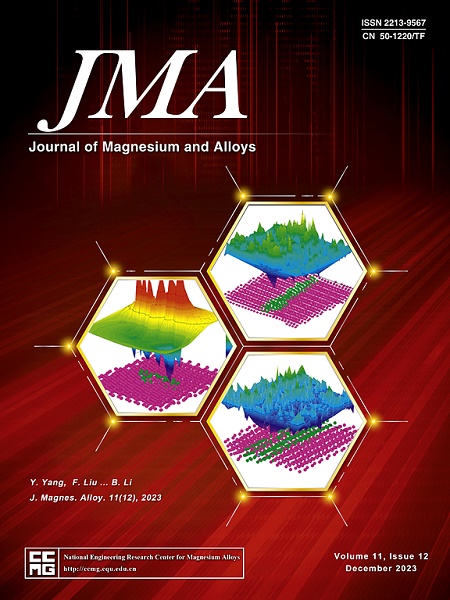A novel carbon-induced-porosity mechanism for improved cycling stability of magnesium hydride
IF 15.8
1区 材料科学
Q1 METALLURGY & METALLURGICAL ENGINEERING
引用次数: 0
Abstract
MgH2 has been extensively studied as one of the most ideal solid hydrogen storage materials. Nevertheless, rapid capacity decay and sluggish hydrogen storage kinetics hamper its practical application. Herein, a Ni/C nano-catalyst doped MgH2 (MgH2![]() Ni/C) shows an improved hydrogen absorption kinetics with largely reduced activation energy. Particularly, the MgH2
Ni/C) shows an improved hydrogen absorption kinetics with largely reduced activation energy. Particularly, the MgH2![]() Ni/C displays remarkable cycling stability, which maintains a high capacity of 6.01 wt.% (98.8% of initial capacity) even after 50 full hydrogen ab/desorption cycles, while the undoped MgH2 counterpart retains only 85.2% of its initial capacity. Detailed microstructure characterizations clearly reveal that particle sintering/growth accounts primarily for the deterioration of cycling performance of undoped MgH2. By comparison, MgH2
Ni/C displays remarkable cycling stability, which maintains a high capacity of 6.01 wt.% (98.8% of initial capacity) even after 50 full hydrogen ab/desorption cycles, while the undoped MgH2 counterpart retains only 85.2% of its initial capacity. Detailed microstructure characterizations clearly reveal that particle sintering/growth accounts primarily for the deterioration of cycling performance of undoped MgH2. By comparison, MgH2![]() Ni/C can maintain a stable particle size with a growing porous structure during long-term cycling, which effectively increases the specific surface of the particles. A novel carbon-induced-porosity stabilization mechanism is proposed, which can stabilize the proportion of rapid hydrogen absorption process, thus dominating the excellent cycling performance of MgH2
Ni/C can maintain a stable particle size with a growing porous structure during long-term cycling, which effectively increases the specific surface of the particles. A novel carbon-induced-porosity stabilization mechanism is proposed, which can stabilize the proportion of rapid hydrogen absorption process, thus dominating the excellent cycling performance of MgH2![]() Ni/C. This study provides new insights into the cycling stability mechanism of carbon-containing Mg-based hydrogen storage materials, thus promoting their practical applications.
Ni/C. This study provides new insights into the cycling stability mechanism of carbon-containing Mg-based hydrogen storage materials, thus promoting their practical applications.
提高氢化镁循环稳定性的新型碳诱导孔隙机制
MgH2作为最理想的固体储氢材料之一,得到了广泛的研究。然而,快速的容量衰减和缓慢的储氢动力学阻碍了它的实际应用。本文中,掺杂MgH2的Ni/C纳米催化剂(MgH2Ni/C)的氢吸收动力学得到改善,活化能大幅降低。特别是,MgH2Ni/C表现出显著的循环稳定性,即使经过50次完整的ab/解吸循环,其容量仍保持在6.01 wt.%(初始容量的98.8%),而未掺杂的MgH2仅保持其初始容量的85.2%。详细的微观结构表征清楚地表明,颗粒烧结/生长是导致未掺杂MgH2循环性能恶化的主要原因。相比之下,MgH2Ni/C在长期循环过程中可以保持稳定的粒径,孔隙结构不断增长,有效地增加了颗粒的比表面积。提出了一种新的碳诱导孔隙稳定机制,该机制可以稳定快速吸氢过程的比例,从而主导了MgH2Ni/C优异的循环性能。本研究为含碳镁基储氢材料的循环稳定性机理提供了新的认识,从而促进了其实际应用。
本文章由计算机程序翻译,如有差异,请以英文原文为准。
求助全文
约1分钟内获得全文
求助全文
来源期刊

Journal of Magnesium and Alloys
Engineering-Mechanics of Materials
CiteScore
20.20
自引率
14.80%
发文量
52
审稿时长
59 days
期刊介绍:
The Journal of Magnesium and Alloys serves as a global platform for both theoretical and experimental studies in magnesium science and engineering. It welcomes submissions investigating various scientific and engineering factors impacting the metallurgy, processing, microstructure, properties, and applications of magnesium and alloys. The journal covers all aspects of magnesium and alloy research, including raw materials, alloy casting, extrusion and deformation, corrosion and surface treatment, joining and machining, simulation and modeling, microstructure evolution and mechanical properties, new alloy development, magnesium-based composites, bio-materials and energy materials, applications, and recycling.
 求助内容:
求助内容: 应助结果提醒方式:
应助结果提醒方式:


